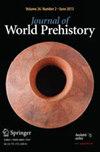Living Mesolithic Time: Narratives, Chronologies and Organic Material Culture
IF 3.1
1区 历史学
Q1 ANTHROPOLOGY
引用次数: 6
Abstract
British and Irish Mesolithic studies have long been characterized by a reliance on broad-scale lithic typologies, both to provide chronologies, and in discussion of ‘cultural’ groups. More recently, traditional narrative structures—period definitions of ‘Early’ and ‘Late’, or culture typologies—have been complemented by a host of other evidence. This has included new studies of site stratigraphy, evidence for seasonality, and material culture chaîne opératoire chronologies, which place a greater emphasis on both temporal precision and the lived experiences of Mesolithic peoples. This paper will consider how the study of organic artefacts forces these narrative scales into acute focus, and presents an opportunity to explore the challenges in synthesizing different forms of data. We discuss how the evidence from sites in Ireland and Britain allows for new approaches, and highlight some of the challenges that this evidence presents, not least the perennial issue of moving from site-specific data to broader narratives. While the nature of earlier prehistoric evidence makes this an especially obvious issue for Mesolithic studies, it is one which generally besets archaeology. We suggest that in order to move beyond this in earlier prehistoric studies specifically, we need to make better use of all evidence sources, however seemingly prosaic, including antiquarian collections in museums, and chance and casual finds. Only by including the raft of available data, and recognizing its utility beyond the sum of individual apparently uninspiring parts, can we begin to move from generalizing narratives to more nuanced archaeological understandings of past material worlds.活的中石器时代:叙事、年表和有机物质文化
长期以来,英国和爱尔兰的中石器时代研究的特点是依赖于大规模的石器类型学,既提供年表,也讨论“文化”群体。最近,传统的叙事结构——“早期”和“晚期”的时期定义,或文化类型学——得到了大量其他证据的补充。这包括对遗址地层学的新研究,季节性的证据,以及物质文化的研究,这些研究更加强调时间的准确性和中石器时代人民的生活经历。本文将考虑有机人工制品的研究如何迫使这些叙事尺度成为尖锐的焦点,并提供了一个探索综合不同形式数据的挑战的机会。我们讨论了来自爱尔兰和英国遗址的证据如何允许新的方法,并强调了这些证据所带来的一些挑战,尤其是从特定地点的数据到更广泛的叙述的长期问题。虽然早期史前证据的性质使这成为中石器时代研究的一个特别明显的问题,但它通常是一个困扰考古学的问题。我们建议,为了在早期的史前研究中超越这一点,我们需要更好地利用所有的证据来源,无论这些证据来源看起来多么平淡无奇,包括博物馆里的古物收藏,以及偶然和偶然的发现。只有包括大量的可用数据,并认识到它的效用超越了单个明显乏味的部分的总和,我们才能开始从概括叙述转向对过去物质世界更细致入微的考古理解。
本文章由计算机程序翻译,如有差异,请以英文原文为准。
求助全文
约1分钟内获得全文
求助全文
来源期刊

Journal of World Prehistory
Multiple-
CiteScore
5.30
自引率
0.00%
发文量
8
期刊介绍:
Aims and scopeJournal of World Prehistory is an international forum for the publication of peer-reviewed, original treatments of the prehistory of an area or larger region. It was founded nearly thirty years ago with the remit of providing researchers, instructors and students with timely and authoritative research syntheses from all fields of archaeology. Journal of World Prehistory continues to lead in this field. Our classic articles may be 20,000 or 25,000 words long, as appropriate (excluding their extensive bibliographies). Since 2008 they have been joined by shorter (around 10,000 words), position pieces, which provide in-depth, thoughtful development of data and concepts, including interventions in controversies that unfold in our pages. These, written in a fashion interesting and accessible to all archaeologists, are often paired with a longer treatment in a single volume. In addition, readers now benefit from thematic special issues and double issues, in which a number of leading authors deal with a key theme in world prehistory, such as the origins of metallurgy (2009, volumes 22: 3 and 4), or the East Asian Neolithic (2013, in preparation). All papers are available first online, followed by the print edition. We aim to be truly global in coverage, with recent articles dealing, inter alia, with Amazonian lithics, the late Jomon of Hokkaido, the Bronze Age in Southeast Asia, the Neanderthal settlement of Doggerland, Neolithic networks in Western Asia, younger Dryas Paleo-Indian adaptations, and state formation in the Horn of Africa. Articles benefit from multi-language abstracts where appropriate, and we work closely with authors who do not have English as a first language to present major syntheses in a clear and concise way to an international audience. Traditionally, JWP focuses on earlier periods, but it includes the beginnings and early development of complex societies, and our understanding of ‘prehistory’ is broad and inclusive: for guidance on chronological scope, as well as our calendrical conventions, see the editorial article ‘Prehistory vs. Archaeology: terms of Engagement’ http://www.springerlink.com/content/346142p032604447/ Our unique remit means that we do not encourage the submission of unsolicited papers; rather, specific proposals are encouraged and then guided prior to independent peer review. Our aims and the way we fulfil them, with close contact with authors throughout the publication process, mean that JWP is not a venue for the simple and rapid dissemination of new results. Whilst we expect scholarship to be current, with syntheses including much new data, our readers look to us for definitive area/period coverage that will have continuing value.If you are proposing an article or special theme for Journal of World Prehistory, please read the Instructions for authors.Rated ''A'' in the European Reference Index for the Humanities (ERIH)?Journal of World Prehistory is rated ''A'' in the ERIH, a new reference index that aims to help evenly access the scientific quality of Humanities research output. For more information visit http://www.esf.org/research-areas/humanities/activities/research-infrastructures.htmlRated ''A'' in the Australian Research Council Humanities and Creative Arts Journal List. For more information, visit: http://www.arc.gov.au/era/journal_list_dev.htm
 求助内容:
求助内容: 应助结果提醒方式:
应助结果提醒方式:


